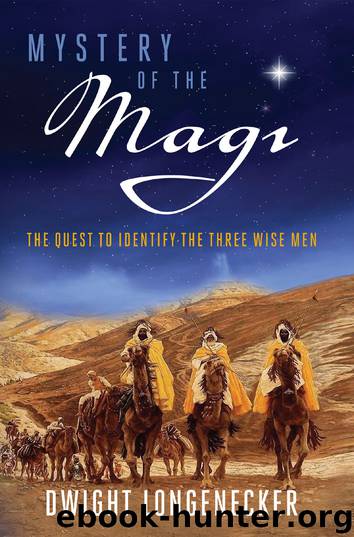Mystery of the Magi by Dwight Longenecker

Author:Dwight Longenecker
Language: eng
Format: epub
ISBN: 9781621576563
Publisher: Regnery Publishing
Published: 2017-09-30T04:00:00+00:00
they were clearly already in a process of metamorphosis [from a nomadic to a settled civilization] for they had acquired possessions that were not easily transported in a nomadic life. Such immovables needed protection, and for this they must have had at least a general concept of central organization. They had, we are told, a special rock (petra), which was virtually impregnable since it had only one path to the top, and there they stored their most valuable possessions.1
The first mention of the Nabateans in the historical record comes toward the end of the fourth century BC, when they defended themselves from the Greeks. After the death of Alexander the Great in 323 BC, his empire was torn apart in a power struggle. One of his generals, Antigonus the One-Eyed, attempted to gain control, and around 312 BC, as he moved south through Syria, Antigonus instructed his general Athenaeus to attack the Nabateans. Their strategic victory over the Greeks established them as a major force in the region. Taylor observes, “The pragmatism and diplomacy they had displayed—for the first time to the ‘civilized’ world—were repeated in different ways, and developed, over the following centuries in their relationships with their neighbors.”2
During the next few centuries, the Nabateans minded their own business, more concerned about developing trade than about becoming a political or military power. Then in the century before the birth of Jesus Christ, when they had settled in Petra and established a monarchy, their history starts to come into political and cultural focus. The Jewish historian Josephus records that when the Hasmonean king of Judea, Alexander Jannaeus (d. 76 BC), besieged the coastal town of Gaza, the citizens of the city expected help from the Nabatean king, Aretas II (d. 96 BC).3 A few decades later Aretas III (d. 62 BC)—known as “Philhellen,” or friend of the Greeks—expanded the Nabatean kingdom, building Greek-style temples and tombs in Petra and raising the level of sophistication of Nabatean culture.4
As the Greek empire crumbled, the wealthy Nabateans became more prominent. Dominating the Arabian trade routes and southern Judea, they came into conflict with the rising power of Rome.5 It was precisely at this time that the Nabateans became increasingly involved in political events, giving them a reason to be very interested in a newborn king of the Jews.
Download
This site does not store any files on its server. We only index and link to content provided by other sites. Please contact the content providers to delete copyright contents if any and email us, we'll remove relevant links or contents immediately.
The Gnostic Gospels by Pagels Elaine(2027)
Devil, The by Almond Philip C(1899)
Jesus by Paul Johnson(1887)
The Nativity by Geza Vermes(1849)
The Psychedelic Gospels: The Secret History of Hallucinogens in Christianity by Jerry B. Brown(1826)
Forensics by Val McDermid(1693)
Going Clear by Lawrence Wright(1571)
Going Clear: Scientology, Hollywood, and the Prison of Belief by Lawrence Wright(1570)
Barking to the Choir by Gregory Boyle(1507)
Old Testament History by John H. Sailhamer(1495)
Augustine: Conversions to Confessions by Robin Lane Fox(1473)
A History of the Franks by Gregory of Tours(1398)
A Prophet with Honor by William C. Martin(1374)
The Bible Doesn't Say That by Dr. Joel M. Hoffman(1372)
The Early Centuries - Byzantium 01 by John Julius Norwich(1359)
by Christianity & Islam(1347)
Dark Mysteries of the Vatican by H. Paul Jeffers(1341)
The First Crusade by Thomas Asbridge(1329)
The Amish by Steven M. Nolt(1254)
